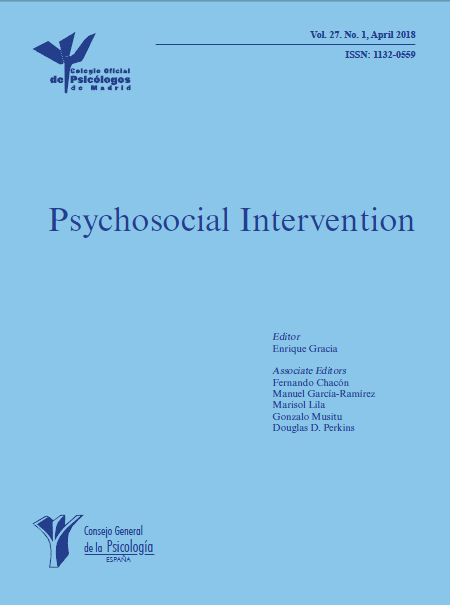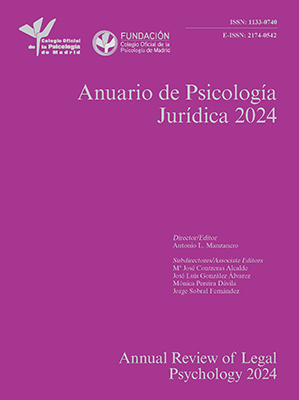
Validation of SchwartzŌĆÖs Human Values Scale in Spanish Children
[La validaci├│n de la Escala de Valores Humanos de Schwartz en ni├▒os y ni├▒as espa├▒oles]
José L. Álvaro1, Elena Pascual Sánchez1, Khalil da Costa Silva2, Ana R. Torres2, Alicia Garrido1, and Miryam Rodríguez1
1Universidad Complutense de Madrid, Spain; 2Universidade Federal da Para├Łba, Brazil
https://doi.org/10.5093/psed2025a3
Received 24 October 2023, Accepted 11 November 2024
Abstract
The research aimed to analyze the validity of the Picture Based Value Survey for Children (PBVS-C) following the Schwartz’s model of values in a sample of 411 Spanish children (207 boys and 204 girls). Multidimensional scaling (MDS) was carried out and the results obtained revealed the replicability of the proposed model in the Spanish population. In addition, differences were verified in terms of sex and age. Participants under ten years old scored higher in the values of self-transcendence, openness to change, and conservation. The sex of the participants, in turn, showed differences in the dimensions of self-transcendence and self-enhancement; boys scored higher in the values of self-enhancement while girls scored higher in the values of self-transcendence.
Resumen
La presente investigación tuvo como objetivo analizar la estructura del cuestionario Picture Based Value Survey for Children (PBVS-C) siguiendo el modelo de valores de Schwartz en una muestra de 411 niños españoles (207 niños y 204 niñas). Se realizó un escalamiento multidimensional (MDS) y los resultados obtenidos revelaron que el modelo propuesto podía replicarse en la población española. Además, se comprobaron diferencias en sexo y edad. Los participantes menores de diez años obtuvieron puntuaciones más altas en los valores de autotrascendencia, apertura al cambio y conservación. El sexo de los participantes, a su vez, mostró diferencias en las dimensiones de autotrascendencia y autopromoción; los niños obtuvieron puntuaciones más altas en los valores de autopromoción, mientras que las niñas obtuvieron puntuaciones más altas en los valores de autotrascendencia.
Palabras clave
Valores humanos, Valores infantiles, Modelo de Schwartz, Escalamiento multidimensionalKeywords
Human values, ChildrenŌĆÖs values, SchwartzŌĆÖs model, Multidimensional scalingCite this article as: Álvaro, J. L., Sánchez, E. P., Silva, K. D. C., Torres, A. R., Garrido, A., & Rodríguez, M. (2025). Validation of SchwartzŌĆÖs Human Values Scale in Spanish Children. Psicolog├Ła Educativa, 31(1), 19 - 27. https://doi.org/10.5093/psed2025a3
Correspondence: miryro01@ucm.es (M. Rodríguez).Human values are one of the central concepts of Social Psychology and follow the development of this discipline (Díez Nicolás & Inglehart, 1994; Hofstede, 1984, 2001; Rokeach, 1973; Schwartz & Bilsky, 1987, 1990). The centrality of this concept lies in its ability to explain behavior based on the articulation between the individual and culture. Thus, from the study of human values it is possible to analyze at the same time the basic motivations for the behavior of individuals, the actions of social actors, and the course that societies follow throughout history (Álvaro et al., 2013). Values are the central core of culture, understood as a set of historically created meanings, through which people communicate, perpetuate, and develop their knowledge and their activities (Geertz, 1973). In a cultural system, values establish criteria about what is correct, appropriate, important, or undesirable and thus guide and motivate people’s behavior (Triandis, 1994, 1996). There are a variety of definitions for human values, having been adopted in investigations in Sociology, Anthropology, and Social Psychology (Rokeach, 1973). One of the main antecedents of the study of values is the work of Thomas and Znaniecki (1958), The Polish peasant in Europe and America, where values are defined as meanings that social groups provide to any empirical data on social reality. At the end of the 1980s and during the 1990s, transcultural theories were incorporated into the study of values, analyzing the consistency of this construct between people and social groups. (Castro & Nader, 2006; Inglehart, 2001; Ros, 2008; Ros & Grad, 1991; Ros et al., 1993; Schwartz, 1992; Torregrosa & Lee, 2000). The study of human values has been shown to be relevant for understanding a wide range of social attitudes and behaviors, such as prejudice and discrimination against minority groups (Álvaro et al., 2015) and gender violence (Canto et al., 2019). Furthermore, values have been used in large-scale studies, allowing the identification of similarities and differences between cultural and socioeconomic contexts (Hofstede 1991; Schwartz, 2008). Values are transmitted to children through a process in which the child becomes a member of a society, learning the rules, beliefs, values, and modes of behavior shared by their social group (Guimond, 2000). Although values are of fundamental importance for the definition of goals and for the transmission of messages in the process of child socialization, only in recent decades have values begun to be investigated directly in children, breaking with the previously predominant tradition of investigating them based on socializing agents such as parents, teachers, media (Döring et al., 2015; Uzefovsky et al., 2016). This study aimed to validate in Spanish the Picture-based Value Survey for Children (PBVS-C) scale (Döring, 2008) for its use with children between 6 and 12 years of age in order to allow its use in research within the linguistic and cultural context of Spain. To this end, the theoretical model that underpinned the development of this instrument will be presented, as well as its applicability in different research contexts. Values in Social Psychology One of the most relevant definitions for the study of values in Social Psychology was presented by Rokeach (1973). In this definition, values are presented as trans-situational goals that act as principles by which people’s actions are regulated. The model developed by Rokeach served as the basis for the formulation of one of the most important theories of values: Schwartz’s (1992) theory of human values. The line of research developed by Schwartz contributed in a crucial way to the conceptualization of values and to the formulation of a theoretical model for the structure and content of human values that have attained empirical consistency in more than 80 countries (Schwartz, 2008; Schwartz et al., 2012). Values are defined by Schwartz and Bilsky (1987, 1990) as follows: they a) are concepts or beliefs, b) concern desirable ends or forms of behavior, c) transcend specific situations, d) guide the selection and evaluation of behaviors or events, and e) are ordered by their relative importance. Another fundamental assumption of Schwartz’s theory is the idea that it is possible to establish 10 (ten) types of human values, thus defined in terms of the motivational goals adopted to satisfy the three needs mentioned above. The values identified by Schwartz are: 1) Self-direction, 2) Stimulation, 3) Hedonism, 4) Achievement, 5) Power, 6) Security, 7) Tradition, 8) Conformity, 9) Benevolence, and 10) Universalism. The motivating needs met by each of these values and the motivations derived from them are shown in Table 1. In addition to classifying the 10 basic human values, Schwartz’s (1992) theory conceives that there is a dynamic relationship between these human values. Depending on the motivational goals they meet, values can establish conflicting or congruent relationships. For example, the values of Power and Achievement converge with each other as they encompass motivational goals related to self-esteem and personal gratification. The dynamic relationships established between human values can be summarized in a circular structure, represented in Figure 1. The idea of organizing the 10 human values into a circular structure derives from the assumption that values form a continuum of correlated motivations, such that values that serve similar motivations are adjacent to each other, while values that serve different motivations occupy opposite positions in the two-dimensional plane. Figure 1 also illustrates another relevant aspect of Schwartz’s (1992) theoretical model. The circular, two-dimensional structure of human values has received empirical validation through the Schwartz’s (1992, 2006) Values Survey (SVS), which consists of a scale with 58 items that represent desirable forms of behavior or desirable purposes, which are evaluated by the participants in terms of their degree of importance, on a 7-point Likert scale, ranging from 7 (utmost importance) to -1 (opposite to my values). The SVS, in addition to presenting significant validity indices in different countries, presents evidence that the four evaluative dimensions have predictive power over a wide range of attitudes and behaviors, such as electoral behavior (Leimgruber, 2011), adherence to diets (Hayley et al., 2015), and discrimination against minority groups (Álvaro et al., 2015). Human Values among Children Although human values have relevance in explaining different social phenomena, the number of studies about values among children and adolescents is still small, especially when it comes to research with children under 10 years of age (Döring et al., 2015). The scarcity of studies on values in children stems from the influence that global models of development, such as Piaget’s (1932) theory of cognitive development and Kohlberg’s (1971) theory of moral development, had on research with children. In general, these theories comprehend that children under 10 years of age would have a thought structure based on concrete or directly observable events, not being able to assess behavior based on abstract constructs such as human values. In contrast to global models of development, more recent approaches, such as the social domain model (Smetana, 2006; Turiel, 1983), have shown that children are sensitive to the different norms that regulate social interactions. The possibility of measuring these concepts in children stems from the development of instruments that consider the language and cultural context of the child and, at the same time, are compatible with their stage of development (Killen & Rutland, 2011). Based on these principles, children are expected to have conscious representations of human values and to be able to establish goals and formulate judgments based on them (Döring et al., 2015). However, the absence of measurement instruments capable of accessing human values in children less than 10 years of age made it impossible for studies to be carried out. Given this limitation, Döring (2008) developed the Picture-based Value Survey for Children (PBVS-C) in order to investigate the human values model proposed by Schwartz’s (1992) with an instrument suitable for stages of development prior to the formal operational stage (10 years of age onwards). Unlike the instruments adopted with adults and adolescents, which represent values based on abstract formulations (e.g., “What I consider most important in my life”), the PBVS-C is a self-report measure in which human values are presented in a concrete way, through 20 figures that cover common scenarios in the child’s daily life, as can be seen in Figure 2. Figure 2 Examples of Items from the Picture-based Value Survey for Children (PBVS-C) (Döring, 2008).   The development of the PBVS-C is based on the consideration that concrete information plays an important role in the constitution of children’s thoughts. Books, movies, and children’s toys, for example, represent vehicles through which abstract concepts such as human values are conveyed in a concrete way (Labbé & Puech, 2005). The use of images allows the formulation of instruments compatible with the child’s level of cognitive development and, therefore, maintains their interest and active participation during the investigation (Schmalt, 2005). The PBVS-C has proven to be reliable in identifying the circular, two-dimensional structure of human values proposed by Schwartz (1992). The use of this model with samples of children in the 6 to 12 years age group in different countries reveals that children differentiate the motivations underlying human values to the same degree as adults do (Cieciuch et al., 2013; Döring et al., 2010; Döring et al., 2011). The studies not only confirm the structure of the model proposed by Schwartz among children, but also point out variables that affect the degree of importance that children attribute to each of the evaluative dimensions. Regarding this aspect, a child’s age and sex have been identified as important predictors. Cieciuch et al. (2016) applied the PBVS-C in a sample of 801 children, aged 7 to 11 years. The authors not only confirmed the structure of values, but also observed changes in the hierarchy of values as a function of age: as the child approaches adolescence, the importance attributed to the dimensions of Conservation and Self-enhancement decreased, and the importance related to the dimensions of Openness to change and Self-transcendence increased. As for the differences according to the child’s sex, it is worth highlighting the study conducted by Döring et al. (2015). It is noteworthy that in this study the validity of the PBVS-C was confirmed through a cross-cultural research, covering samples from Germany, Italy, Poland, Bulgaria, the United States, and New Zealand. A total of 3,088 children, aged 6 to 11 years, were interviewed. The results confirmed the compatibility with Schwartz’s (1992) proposed model and identified a child’s sex as one of the main variables that explain the differences in the degree of importance attributed to human values. The differences in the value profile observed according to gender reflect the importance of gender in the expression of values among children. Gender is one of the social categories most readily recognized by children. Even in the preschool phase (before the age of 6), children are aware of the stereotypes associated with gender (Bigler & Liben, 2006). Furthermore, children feel culturally pressured to adjust their attitudes and behaviors according to gender stereotypes and recognize parents and peers as the main sources of normative pressure (Schroeder & Liben, 2021). In a research carried out with adults, Schwartz and Rubel (2005) found that women tend to prioritize the values of Self-transcendence and Conservation, while men show greater adherence to the values of Self-enhancement and Openness to change. Systematically reviewing research on children’s motivations, Blakemore et al. (2009) found that girls tended to prefer activities and toys related to care and emotional attachment, while boys preferred activities and toys related to competition and the demonstration of power. Such differences are compatible with the contrast between the dimensions of Self-enhancement and Self-transcendence, observed by Schwartz and Rubel when comparing the evaluative profile of adult men and women. The cross-cultural research by Döring et al. (2015) has confirmed this contrast by identifying that girls attributed greater importance to the values of Self-transcendence and Conservation, while boys prioritized the values of Self-enhancement. Nevertheless, Openness to change values were equally valued by both sexes. In summary, the development of the PBVS-C opened up new possibilities for investigating the conduct and social judgments that emerge in childhood, especially by endorsing the assumption that the child acts as an “intuitive moralist” (Thompson et al., 2006), that is, like a social actor capable of differentiating evaluative criteria and itemizing personal priorities in their regard, as adults and adolescents do. Given the above, this paper presents the validation of the Picture-based Value Survey for Children (PBVS-C) in Spanish for children 6 to 12 years of age. In carrying out this study, we sought to achieve the following specific objectives:
Sample A total of 411 children (207 boys and 204 girls) between 6 and 12 years of age (M = 9.58, SD = 1.53), from public (n = 195) and private (n = 216) schools in Madrid, Spain, participated in this study. Procedures and Instruments The Spanish language version of the Picture-based Value Survey for Children (PBVS-C) was adopted (Döring, 2008). The scale consists of 20 boards that present graphic representations compatible with the human values conceived in the Schwartz’s (1992) model, so that for each of the 10 human values there are two boards that represent it. Each board was presented individually. At each presentation of the board, the interviewer asked “What do you think these kids are doing?”. Then, the child is told about the value represented on the board and questioned about its degree of importance (e.g., Universalism Value Board – “These children like to make friends with different people, how much is friendship with different people important to you?”). The degree of importance attributed to the value by the child was operationalized on a 5-point Likert scale (from 1 = not important at all to 5 = very important). In order to adapt the instrument to the child’s understanding, the Likert scale was also graphically represented by means of 5 cards (Figure 3) that present a number of stars corresponding to its value on the scale (e.g., “See, you can answer using these cards with little stars”). In addition to the PBVS-C, sociodemographic data were collected from the participants. For data collection, in accordance with APA standards, authorization to carry out the study was first requested from the school principals. They were informed about the conditions for carrying out the research, in particular the anonymity of the participants and educational institutions, the confidentiality of the answers provided during the studies, the free and voluntary participation, and the child’s right to interrupt participation in the study at any time. Each of these items was duly formalized through the Free and Informed Consent Form (FICF). After authorization from the principals of the educational establishments, authorizations were requested from the parents/guardians of the children for their participation in the research, and authorization was granted under the aforementioned conditions. The children were interviewed at their schools, with the presence of the interviewer. Data Analysis Identification of the Dimensions of Human Values The adequacy of the data obtained through the PBVS-C for the Schwartz’s (1992) theoretical model was verified through a multidimensional scaling (MDS) analysis. This technique adopts measures of intercorrelation between variables as a criterion for similarity. Through MDS, each variable is represented by a point on a two-dimensional plane, so that the degree of similarity between the variables is indicated by their distance: the greater the similarity between the variables, the smaller the distance between their respective points, and the greater the dissimilarity, the greater this distance (Borg & Groenen, 2005). The MDS technique has been recurrently used to verify the prototypical structure of human values, as proposed by Schwartz, including studies on values in children (Cieciuch et al., 2013; Döring et al., 2010). In the two-dimensional MDS plane, the 20 items of the PBVS-C can be represented in a circular structure, organized according to the 10 motivational types previously established by Schwartz (Figure 4). Figure 4 Initial Configuration of the 20 Items of the PBVS-C for the Multidimensional Scaling Analysis.  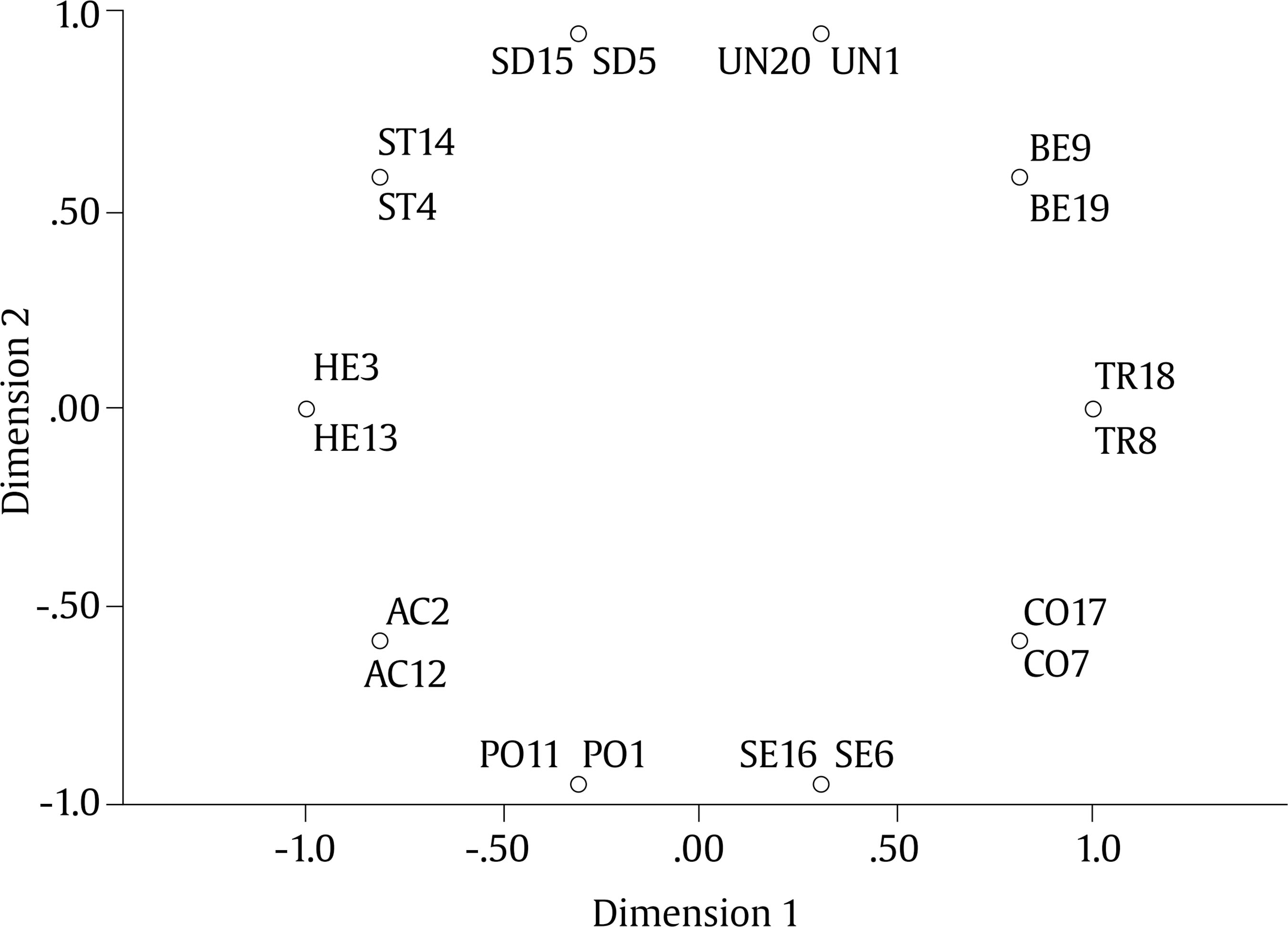 Note. Universalism (UN1 + UN20), Benevolence (BE9 + BE19), Tradition (TR8 + TR18), Conformity (CO17 + CO7), Security (SE6 + SE16), Power (PO1 + PO11), Achievement (AC2 + AC12), Hedonism (HE3 + HE13), Stimulation (ST4 + ST14), and Self-direction (SD5 + SD15). For the MDS analysis, the same techniques used by Döring et al. (2010) were adopted, namely the PROXSAL module in SPSS version 16 was used with the following criteria: stress convergence = .0001, minimum stress = .0001, maximum iterations = 100. Thus, in the two-dimensional MDS plane, it would be possible to verify whether the configuration of the PBVS-C items obtained in this sample would present regions that aggregate items that correspond to values of the same motivational type. In addition to verifying the correspondence between the regions obtained in the two-dimensional plane and the Schwartz assumptions, the MDS analysis provides the Stress 1 index, which indicates how well the data fit the model. For an empirical solution to be considered accurate, it is recommended that the Stress 1 value be less than .30 (Borg & Groenen, 2005). Confirmatory Factor Analysis-CFA. As proposed by Schwartz (2012), once the configuration structure is corroborated, it is necessary to carry out a confirmatory factor analysis (CFA). A magnifying glass strategy allows each of the four higher order values (Self-enhancement, Self-transcendence, Conservation, and Openness to change) to be tested more precisely in separate models which are elaborated for each higher order value. This analysis was conducted using the software AMOS 24. Following previous studies (Cieciuch & Davidov, 2012), the CFA was carried out with the maximum likelihood estimation method, used to investigate the adequacy of the theoretical model to the empirical data, within the scope of structural equation analysis, structural equation modeling (SEM). Five model-fitness indices were selected: 1) c2/df, for which values lower than five can be interpreted as an indication that the theoretical model fits the data; 2) comparative fit index (CFI), an indicator that ranges from zero to one with higher values indicating better fit; a rule of thumb for this index is that .97 is indicative of good fit relative to the independence model, while values greater than .95 may be interpreted as an acceptable fit (Schermelleh-Engel et al., 2003); 3) root mean square error of approximation (RMSEA), which should have values close to 0. Some authors however adopt a more conservative approach, maintaining that acceptable RMSEA values should be below .05 and with a not very large confidence interval (Raykov & Marcoulides, 2006); 4) standardized root mean square residuals-SRM; this is a standardized version of the root mean square residual (RMR), which is a measure of the mean absolute covariance residual; perfect model fit is indicated by RMR = 0, and increasingly higher values indicate worse fit (Kline, 2011); and 5) probability of close fit (p-close), an index that is the probability that RMSEA is significantly greater than zero. The null hypothesis for this comparison is that RMSEA does not differ from zero. PCLOSE is the p-value for rejecting the null hypothesis that the model fits the individual subject’s data, a p-close value less than .05 indicates that RMSEA is greater than zero, and therefore the model does not fit (James et al., 2009). Effects of Child’s Sex and Age on Adherence to Human Values In order to verify the effect of a child’s sex and age on adherence to human values, an analysis of variance (ANOVA) was done with a between-subjects design, taking child’s age (varying in two levels, 6-10 years vs. 11-12 years) and sex (male vs. female) as independent variables (IV), and the four evaluative dimensions proposed by Schwartz as dependent variables (DVs). Structure of Human Values Multidimensional scaling (Figure 5; Stress 1 = .152) indicated that the data obtained in the present sample with the PBVS-C are organized into four regions compatible with the theoretical model proposed by Schwartz (1992): Self-transcendence, Conservation, Openness to change, and Self-enhancement. Figure 5 Result of the Multidimensional Scaling of the PBVS-C Items.  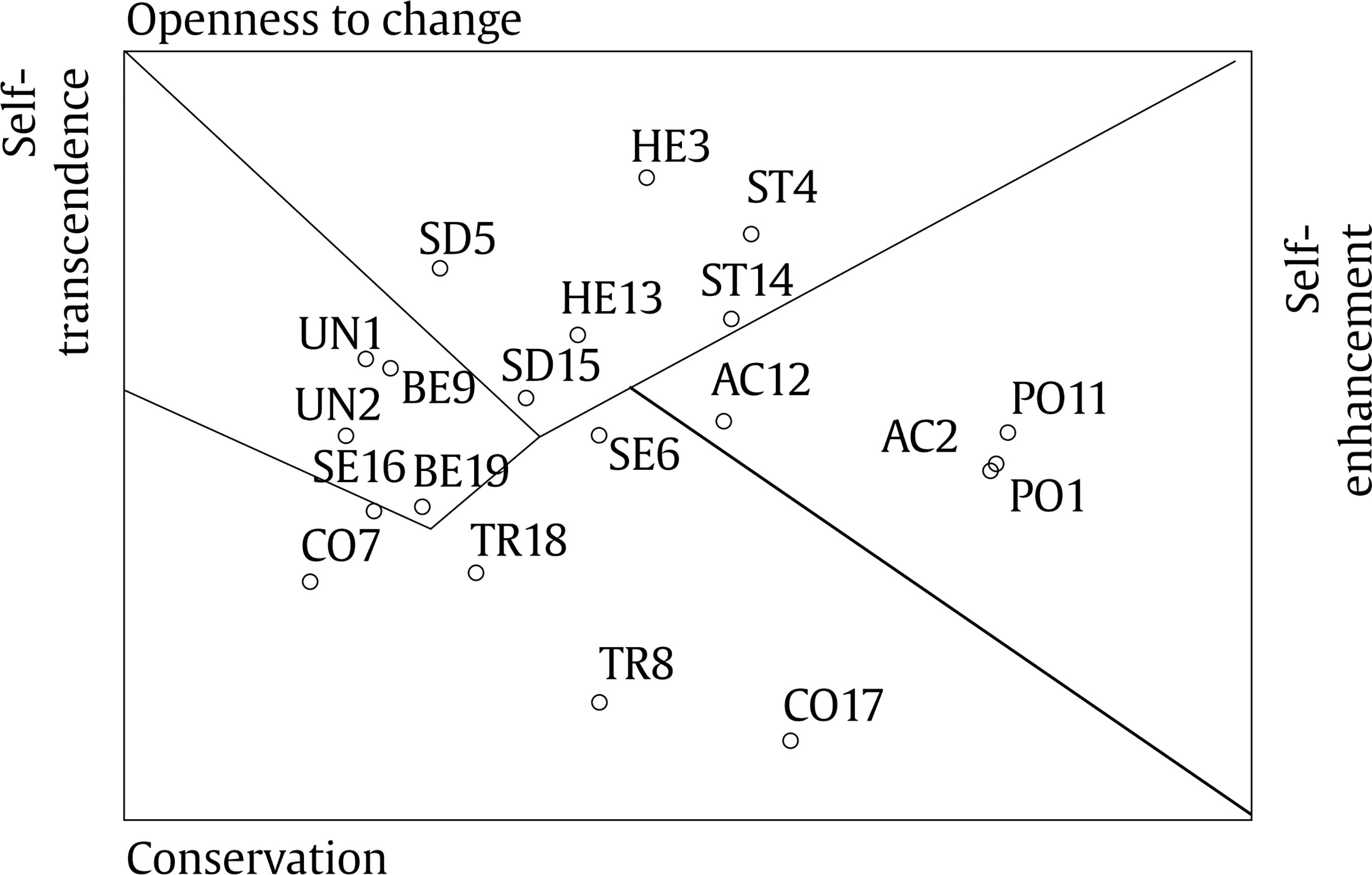 Note. Stress 1 = .152, UN = Universalism, BE = Benevolence, TR = Tradition, CO = Conformity, SE = Security, PO = Power, AC = Achievement, HE = Hedonism, ST = Stimulation, and SD = Self-direction. As shown in Figure 5, the dimension of Self-enhancement (α = .67) comprises the items referring to Power (PO1 + PO11) and Achievement (AC2 + AC12). Openness to change dimension (α = .62) encompasses the items Hedonism (HE3 + HE13), Self-direction (SD5 + SD15), and stimulation (ST4 + ST14). Benevolence (BE9 + BE19) and Universalism (UN1 + UN20) items are grouped in the Self-transcendence region (α = .63). Finally, the Security (SE6 + SE16), Tradition (TR8 + TR18), and Conformity (CO7 + CO17) items are found in the Conservation region (α = .45). The multidimensional scaling analyses carried out according to the sex of the participants confirmed the adequacy of the structure found both among boys (Stress 1 = .172) and among girls (Stress 1 = .210). Figure 6 shows the distribution of values according to the sex of the participants. Figure 6 Results of the Multidimensional Scaling of the PBVS-C.  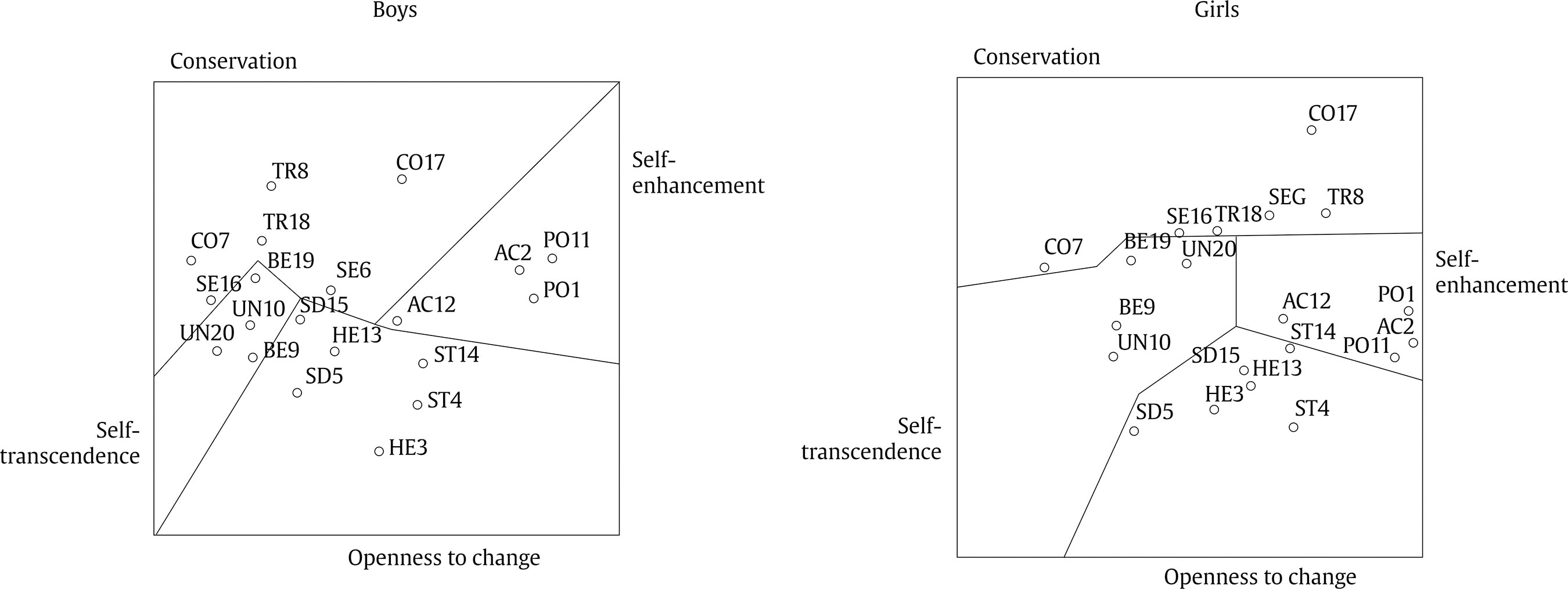 Note. Items for boys (stress 1 = .172) and girls (stress 1 = .210). UN = Universalism, BE = Benevolenc, TR = Tradition, CO = Conformity, SE = Security, PO = Power, AC = Achievement, HE = Hedonism, ST = Stimulation, SD = Self-direction. Magnifying Glass Confirmatory Factor Analysis For each higher order category of values CFA models that represented the more narrowly defined values were generated. It was expected that these models would encompass the structure underlying Schwartz’s (1992) theory. Table 2 presents the model fit indexes for the four models. As shown in Table 2, all the dimensions of the PBVS-C present good global fit indices, with Self-transcendence and Self-enhancement having a better fit than Openness to change and Conservation values. However, Figure 7 shows collinearity between achievement and power values and between benevolence and universalism values. Table 2 Fit Indices of CFA Analysis of PBVS-C   Note. χ2/df = chi-square/degrees of freedom; CFI = comparative fit index; RMSEA = root mean square error of approximation; SRMR = standardized root mean square residual; PCLOSE = probability of close fit. Descriptive Analyses The means, standard deviations, and minimum and maximum values of importance attributed to each of the dimensions of human values are shown in Table 2. As can be seen in Table 3, the values that have greater importance for the participants are Self-transcendence values (M = 4.68, SD = 0.38), while Self-enhancement values were significantly less important for the participants (M = 2.93, SD = 0.80), t(410) = 36.81, p < .001. Effects of Age and Sex of the Participants on Adherence to Human Values The analyses indicated main effects as a function of participants’ age, F(4, 404) = 5.848, p < .001, η² = .055, and sex, F(4, 404) = 8.875, p < .001, η² = .081, on the adherence to human values. There was no significant effect of the type of school (public vs. private) on adherence to values, F(4, 400) = .586, p = .673, η² = .006. However, there was a significant interaction effect between participant’s sex, age, and type of school, F(4,400) = 2.51, p = .041, η² = .024, as well as an effect, tending toward significant, of the interaction between participants’ sex and age on the adherence to human values, F(4, 404) = 2.256, p = .06, η² = .022. Child’s age resulted in significant effects on adherence to Self-transcendence values, F(1, 410) = 7.251, p = .007,η² = .018, Openness to change, F(1, 410) = 5.379, p = .021, η² = .013, and Conservation, F(1, 410) = 4.372, p = .037, η² = .011. Children under 10 years of age presented greater adherence to Self-transcendence values (M = 4.71, SD = 0.37) than the older children (M = 4.60, SD = 0.39), t(230.18) = 2.739, p = .007, d = 0.36. Younger children also showed greater adherence to Conservation values (M = 4.11, SD = 0.46) than the older children (M = 4.01, SD = 0.48), t (409) = 2.109, p = .036, d = 0.06. On the other hand, older children presented greater adherence to Openness to change values (M = 4.58, SD = .39) than children under 10 years of age (M = 4.47, SD = 0.42), t(409) = -2,504, p = .013, d = 0.24. Table 4 Mean and Standard Deviation Values for the Importance Attributed to Openness to Change Values, Distributed according to Participants’ Sex, Age, and School (N = 411)   No differences were observed in adherence to Self-enhancement values with respect to the age of the participants, F(1, 410) = .059, p = .809, η² < .001. Participants’ sex resulted in differences regarding adherence to the values of Self-transcendence, F(1, 410) = 13.690, p <.001, η² = .033, and Self-enhancement, F(1, 410) = 12.801, p <.001, η² = .049. These differences result from the boys showing greater adherence to Self-enhancement values (M = 3.11, SD = 0.82) than girls (M = 2.75, SD = 0.75), t(409) = 4.671, p < .001, d = .46, whereas girls showed greater adherence to Self-transcendence values (M = 4.76, SD = 0.29) compared to boys (M = 4.60, SD = 0.43), t(360.27) = -4.421, p < .001, d = 0.46. Participants’ sex did not result in significant differences in adherence to Conservation values, F(1, 410) = .065, p = .799, η² < .001, nor to Openness to change values, F(1, 410) = 0.164, p = .685, η² <.001. Table 4 shows the mean and standard deviation values, distributed according to the sex, age, and school of the participants, and the degree of importance attributed to each of the four dimensions of human values. The interaction between sex, age, and type of school resulted in significant differences only in the adherence to Openness to change values, F(1, 411) = 7.368, p = .007, η² = .018. As can be seen in Table 4, differences depending on the child’s sex are only significant among children under 10 years of age who study in private schools (F = 2.41, p < .001). Scheffé’s post hoc test indicated that, in this group, boys presented significantly less adherence to the Openness to change values than did girls (p = .013). The interaction between participants’ sex, age, and type of school had no significant effect on adherence to the values of Self-enhancement, F(1, 411) = .611, p = .435,η² = .002, Conservation, F (1, 411) = 0.325, p = .569, η² = .001, and Self-transcendence, F(1, 411) = 0.203, p = .653, η² = .001. The general aim of this study was to validate the Picture-based Value Survey for Children (PBVS-C) scale (Döring, 2008) in Spanish for its use with children between 6 and 12 years of age, in order to allow its use in studies within the linguistic and cultural context of Spain. More specifically, the intent was to analyze the different evaluative dimensions and their relations of proximity and contrast, as proposed in Schwartz’s (1992) Theory of Human Values, to compare the structure of the PBVS-C values as a function of the child’s age and sex, and, finally, to compare the structure of the PBVS-C values with other samples from cultural and sociodemographic contexts similar to the Spanish context. The data obtained faithfully replicate the structure of the PBVS-C obtained by Döring (2008) and verified in previous studies (Bilsky et al., 2013; Cieciuchet et al., 2013; Döring et al., 2010; Döring et al., 2015) and therefore fit Schwartz’s (1992) motivational model of values, represented in four major dimensions: Self-enhancement, Conservation, Openness to change, and Self-transcendence. The children considered Self-transcendence values (Benevolence + Universalism) as the most important and Self-enhancement values (Power + Achievement) as the least important, with these results being identical to the cross-cultural study conducted by Döring et al. (2015). Regarding reliability, it was observed that the dimensions found presented intermediate values. Nevertheless, these values are acceptable, given that this scale has a small number of items (Schwartz, 2012). The results confirm that the pictorial representation of human values allows their investigation in children at the stage of concrete operational development, that is, before the age of 10 (Piaget, 1932), overcoming an old limitation in the study of human values that restricted its field of research to populations over 10 years of age (Döring et al., 2015). At the same time, it converges with new research on child development that shows that children are capable of making assessments based on abstract concepts such as values (Smetana, 2006; Turiel, 1983). Regarding the differences in children’s age, it was identified that younger children (6-10 years old) have greater adherence to Conservation (Security, Tradition, and Conformity) and Self-transcendence (Benevolence, Universalism) values, while lower adherence to Openness to change (Self-direction, Stimulation, Hedonism). Older children (11-12 years of age), in turn, have an inverse evaluative profile, as they have less adherence to Conservation and Self-transcendence values and give higher priority to Openness to change values. Data also indicate significant differences as a function of the child’s sex, reflecting the gender differences observed in adult populations (Farías Nazel, 2007; Hofstede, 1994; Schwartz & Rubel, 2005). Boys give more priority to Self-enhancement values (Power, Achievement) while Self-transcendence values (Benevolence, Universalism) are more important to girls. Such differences occur regardless of a child’s age. In the interaction between children’s sex and age, it was found that in private schools, among younger children (6-10 years old), girls have greater adherence to the values of Openness to change than do boys. Among older children (11-12 years of age), however, these differences do not occur. In public schools, in turn, no differences were observed in adherence to these values depending on the sex or age of the child. These results should be interpreted with caution. Although the literature suggests that there is a relationship between values and socioeconomic indicators, more research is needed. Some studies suggest that higher socioeconomic status is associated with greater adherence to Self-promotion and Openness to change values, while less favorable socioeconomic conditions would be associated with greater adherence to Conservation and Self-transcendence values (Carey & Markus, 2017; Stephens et al., 2014; Stephens et al., 2007). Since the present study only considered the type of school (private vs. public) where the child is enrolled, and since a reliable analysis of socioeconomic status depends on the survey of other indicators that make up this variable, such as family income, parents’ level of education and their occupation (Rea, 2023), we suggest that future studies consider the dimension of the socioeconomic aspect. Differences according to sex and age elucidate important aspects of a child’s social development process. As for age, the literature on child development converges in pointing out the age of 10 years as an important milestone. On the one hand, this period is characterized by attaining the formal operational stage, which enhances a child’s ability to recognize norms and expectations of different social groups. Such a change is accompanied by an expansion of the child’s social relations, which gradually starts to constitute bonds independent from adults (Abrams et al., 2007; Killen & Rutland, 2011; Piaget, 1932). Greater adherence to Openness to change values, therefore, converges with the stage in which the child seeks greater autonomy of thought and action in relation to adults. The differences observed in terms of a child’s sex show that, from an early age, this category significantly influences socialization practices, in which boys are encouraged to assume positions of power and show competence, and girls are encouraged to show empathy and care for others (Blakemore et al., 2009). The consistency of these differences in various countries (Döring et al., 2015) and their persistence into adulthood (Schwartz & Rubel, 2005) reveal the need for future research to explore the interrelationships between gender and the socialization messages conveyed to children. In an observational study, Morrongiello and Dawber (1999), for example, identified that when a child is faced with a problem (e.g., a conflict with other children), parents tend to encourage boys to take risks and resolve their problems independently, but tend to protect their daughters and provide solutions to their problems. Such differences in socialization practices signal the normative effect of gender roles on children (Bigler & Liben, 2006; Schroeder & Liben, 2021) and open the way for future research to analyze this effect on adherence to gender stereotypes and sexist behaviors in childhood. Limitations and Future Directions The Picture-Based Value Survey for Children (PBVS-C) is the first self-report measure developed for measuring human values in children under 10 years of age, in accordance with Schwartz’s (1992) theoretical model. Although the present research has confirmed the predicted theoretical structure and has presented results compatible with other investigations (Döring et al., 2010; Döring et al., 2015), there are other relevant aspects to be explored in future studies. One of the points to be analyzed is the verification of the stability of Schwartz’s model two-dimensional structure over time. In this sense, it would be important to carry out longitudinal studies, which could elucidate more accurately processes of stability and change in evaluative preferences as a function of developmental variables (e.g., entering adolescence/adult life) or broader societal variables, such as cultural or socioeconomic changes. It is worth noting that this research was carried out with children belonging to an urban context. Since the literature points to the existence of differences between rural and urban areas regarding the value profile (Weckroth & Kemppainen, 2023), as well as regarding children’s socialization practices (Chen et al., 2015), future studies could include children from rural areas. Since children’s adherence to values occurs within the socialization process, it is necessary to carry out studies to establish how certain socialization patterns endorsed by agents such as parents, schools, and the media favor adherence to certain types of values at the expense of others. This issue is of key importance, especially for the formulation of interventions in the area of ethnic socialization, since adherence to values of Self-enhancement and Conservation are commonly associated with the expression of negative attitudes and discriminatory behavior against minority groups (Álvaro et al., 2012; Álvaro et al., 2015). Given that Schwartz’s theory also considers a motivational aspect, studies about values in children could also contribute to the elucidation of learning processes more precisely; future studies could analyze how adherence to different human values directs and stimulates children’s behavior and learning process, their well-being, and their engagement in educational activities, as highlighted by Boekaerts et al. (2006). Conflict of Interest The authors of this article declare no conflict of interest. Cite this article as: Álvaro, J. L., Pascual Sánchez, E., da Costa Silva, K., Torres, A. R., Garrido, A., Rodríguez, M. (2025). Validation of Schwartz’s human values scale in Spanish children. Psicología Educativa, 31(1), 19-27. https://doi.org/10.5093/psed2025a3 Funding This research received no specific grant from any funding agency in the public, commercial, or not-for-profit sectors. References |
Cite this article as: Álvaro, J. L., Sánchez, E. P., Silva, K. D. C., Torres, A. R., Garrido, A., & Rodríguez, M. (2025). Validation of SchwartzŌĆÖs Human Values Scale in Spanish Children. Psicolog├Ła Educativa, 31(1), 19 - 27. https://doi.org/10.5093/psed2025a3
Correspondence: miryro01@ucm.es (M. Rodríguez).Copyright © 2025. Colegio Oficial de la Psicología de Madrid


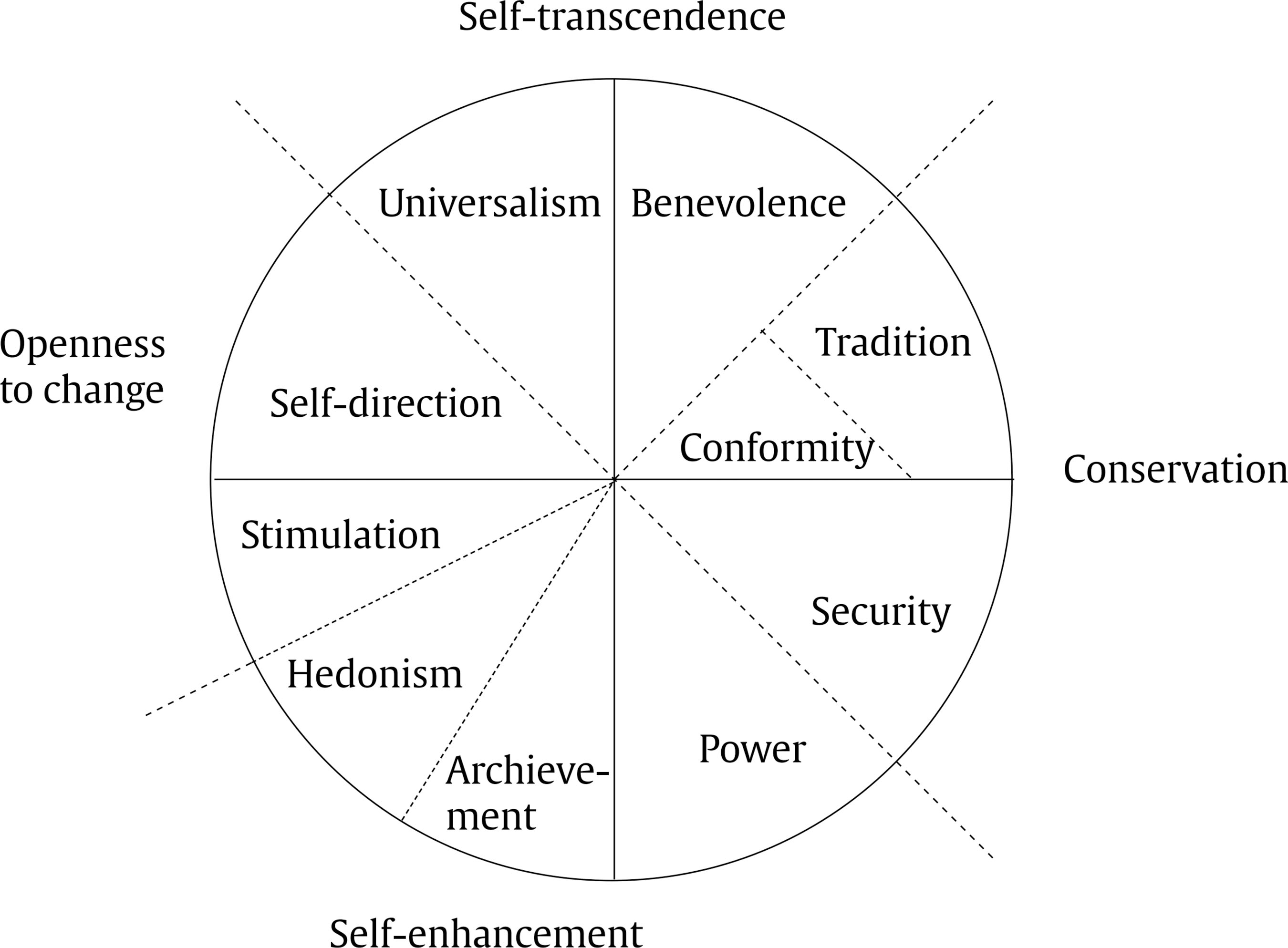


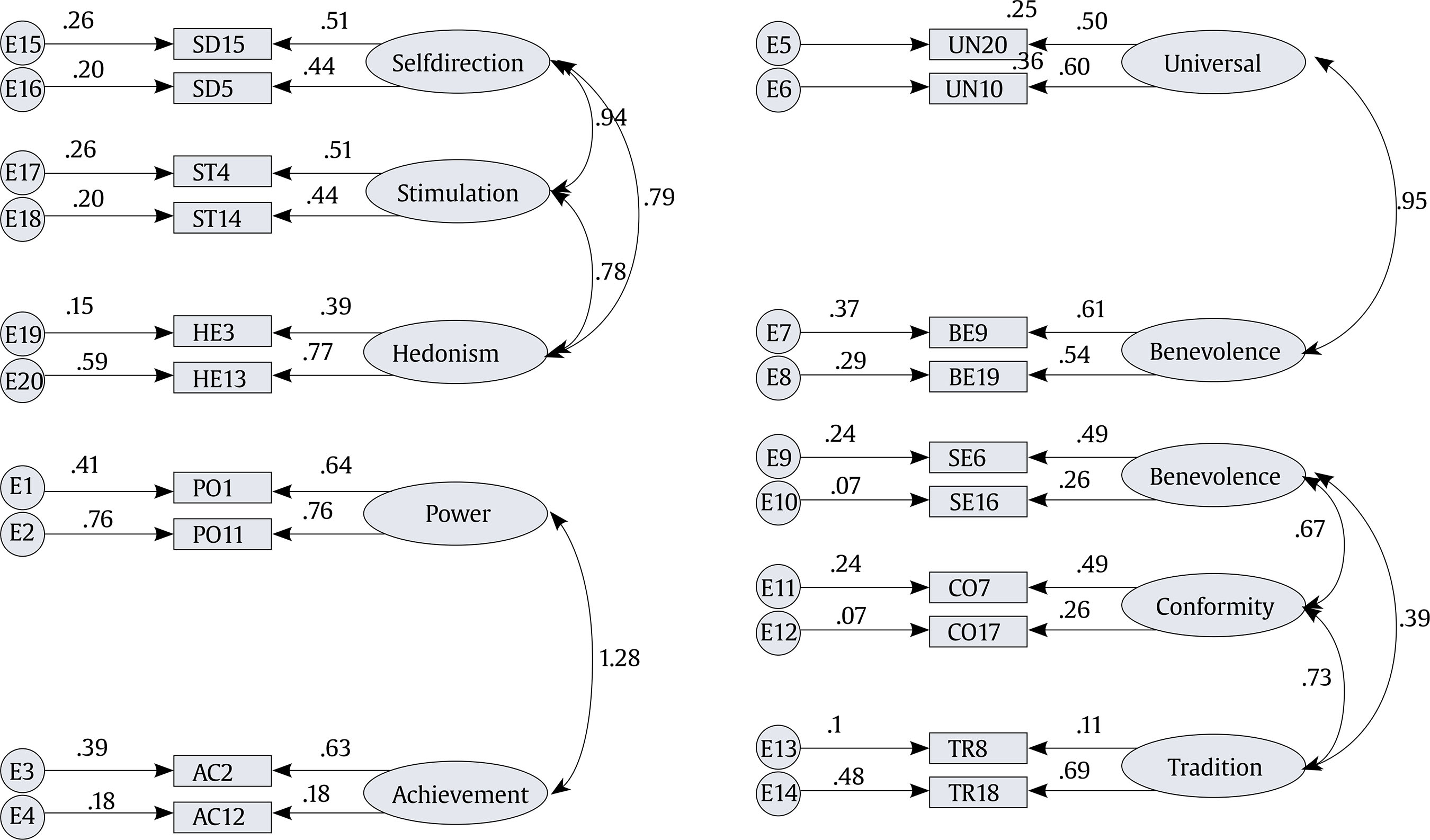







 e-PUB
e-PUB CrossRef
CrossRef JATS
JATS


